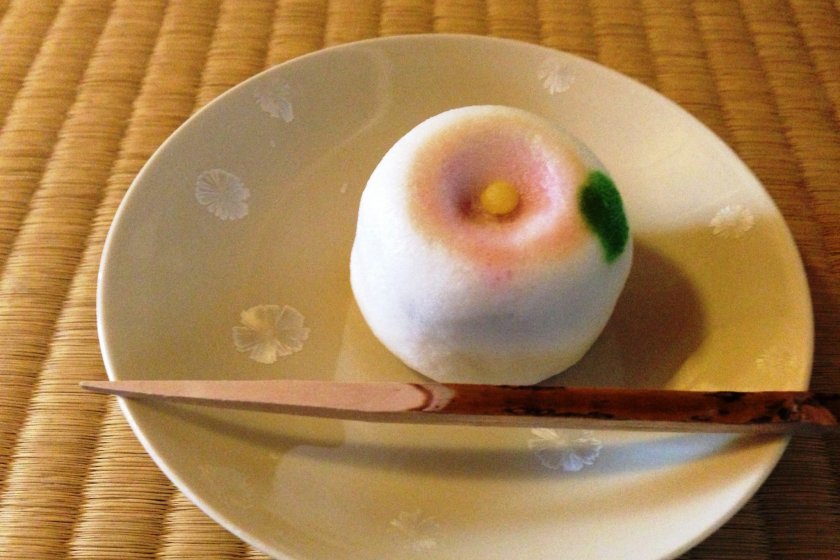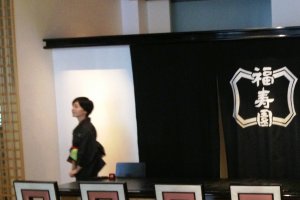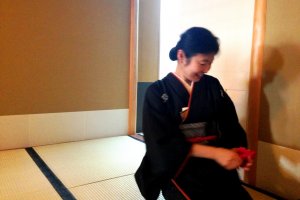Fukujuen was founded in 1790 as a tea merchant in Kyoto, and is long associated with quality Sencha or simmered green tea leaves from its home in Uji in the southern part of Kyoto Prefecture, between Nara and Kyoto. Its flagship store, which has a showroom and tea ceremony room, is located in downtown Kyoto on Shijo Street, near the shopping street or Shotengai at Teramachi Street.
While many beginners may find the tea ceremony intimidating, but here at Fukujuen, they are used to having the most nervous of guests, so you can relax and take in the peace of the ceremony. From the simple layout of the washitsu tatami room, to the beauty of the flowers in the tokonoma, a raised alcove especially designed to display art, every detail is thought of to help the guests clear their mind and focus on the simplicity of tea. So if you can’t sit zazen style on your knees, it is okay to cross your knees.
They only use the best ingredients and materials in the tea ceremony. The beautiful flower arrangements are changed daily for the tea room, while the Kiyomizu yaki tea bowl is hand made in Kyoto. The tea comes from Uji, while the tea whisk, or chasen is from Takayama in Ikoma city, Nara Prefecture, with the reputation of making the best tea whisks in Japan. A tea ceremony may serve one of two kinds of matcha tea. Koicha is a thick, almost mud like concoction, which is kneaded rather than whisked, having a higher percentage of tea. It is very strong and is passed from one guest to another. Usucha, on the other hand, is also called thin tea, and each guest gets their own bowl. Fukujuen serves usucha, which is easier to drink.
Today I came with some guides from the handicrafts association, though a party of two to four can easily fit in the tea ceremony that you can book online or in person.
Each guest has a place in the tea room, and I as the first guest, have the responsibility of making conversation with the host and sets the tone for the rest of the party. The host here tells me that the tsuru or crane and kame or turtle motifs on the first guest’s tea bowl symbolizes long life, and as Japanese Matcha tea is full of antioxidants and Vitamin C, chances are that you will live a little better, having taken part in it.
The second guest’s bowl has motifs from Tenryuji (天龍寺), a world heritage temple in Arashiyama. So you can take a trip around Kyoto from taking part in a tea ceremony.
What I remember most is the smile on the obasan’s face, much like the gentle aunt in the ikebana floral arrangement class who welcomed a shy Scarlet Johanssen in the movie, Lost in Translation. Even though it was full of ritual, she couldn’t help it but have a big smile on her face the whole time, it seemed she was genuinely happy to host us and be part of our experience in Kyoto. It is something that I won’t forget, in her softly spoken English and Japanese, full of encouragement when I am doing the right thing, and giving us small hints to help us enjoy the experience, like suggesting us to cut the wagashi sweets into quarters first with the Kuromoji, a single wooden stick used to pick or cut the Wagashi.
I am often asked how much it costs to take part in a tea ceremony, and how long does it take. The tea ceremony is 2,625 yen per person, with a minimum of two people, and it takes about 30 minutes, so even if you are short of time, it is worth making the effort to experience a quintessential part of Japanese culture in Kyoto. As the tea ceremony room shares the floor with an exhibition room, you may have some noise during the ceremony. However, as it is located in the center of town, it is very accessible.

































